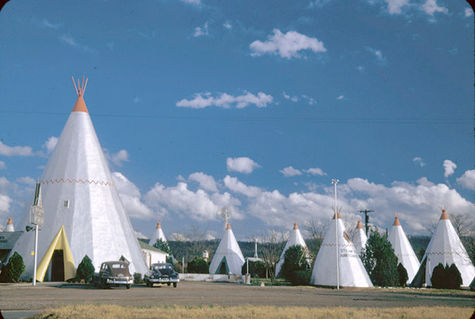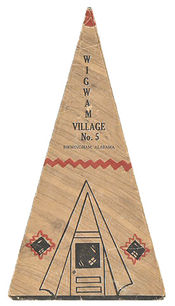Wigwam Village: Difference between revisions
No edit summary |
|||
| (One intermediate revision by the same user not shown) | |||
| Line 5: | Line 5: | ||
[[Image:Wigwam village menu cover.jpg|left|175px]] | [[Image:Wigwam village menu cover.jpg|left|175px]] | ||
Birmingham's Wigwam Village opened in [[1941]] on the newly-opened Bessemer Super Highway just north of the [[Valley Creek]] bridge. Later villages were opened in Holbrook, Arizona; Rialto, California. As part of the franchise agreement a coin-operated radio was installed in each room, with Redford collecting the coins as his commission. | Birmingham's Wigwam Village opened in [[1941]] on the newly-opened Bessemer Super Highway just north of the [[Valley Creek]] bridge. It was constructed by [[W. C. Looney]]<!--Walter Clement Looney-->. Later villages were opened in Holbrook, Arizona; Rialto, California. As part of the franchise agreement a coin-operated radio was installed in each room, with Redford collecting the coins as his commission. | ||
The "village" consisted of a grouping of concrete "teepees", approximately 25' in diameter at the base. A larger teepee at the center served as a guest-registration office and cafe. The rooms were insulated and featured Native American themed hickory furniture and decor and complete baths. The exteriors were coated in aluminum paint with red zig-zag graphics. The cafe menu was printed on teepee-shaped paper. It featured all-day breakfast specials ranging from 35¢ to 50¢ and dinner specials from 40¢ to $1.10. | The "village" consisted of a grouping of concrete "teepees", approximately 25' in diameter at the base. A larger teepee at the center served as a guest-registration office and cafe. The rooms were insulated and featured Native American themed hickory furniture and decor and complete baths. The exteriors were coated in aluminum paint with red zig-zag graphics. The cafe menu was printed on teepee-shaped paper. It featured all-day breakfast specials ranging from 35¢ to 50¢ and dinner specials from 40¢ to $1.10. | ||
| Line 21: | Line 21: | ||
[[Category:Former motels]] | [[Category:Former motels]] | ||
[[Category:Bessemer | [[Category:Bessemer Super Highway]] | ||
[[Category:1941 establishments]] | [[Category:1941 establishments]] | ||
[[Category:1941 buildings]] | [[Category:1941 buildings]] | ||
[[Category:1964 disestablishments]] | [[Category:1964 disestablishments]] | ||
[[Category:1960s demolitions]] | [[Category:1960s demolitions]] | ||
Latest revision as of 10:50, 16 September 2022

The Wigwam Village No. 5 was a tourist court which opened on Bessemer Super Highway (U. S. Highway 11) about 4 miles north of downtown Bessemer in 1941. It was the fifth in a chain of seven such tourist courts developed by Frank Redford of Horse Cave, Kentucky. Bessemer's wigwam village was operated by J. W. Davidson, and later by Judge & Mrs Willis Staton.
Redford built his first teepee-shaped restaurant in Horse Cave in the early 1930s and added 15 smaller guest-cabins in a horseshoe around it in 1933. He patented his "wigwam village" concept in 1936 and built a second one in Cave City, Kentucky a year later. He then sold the blueprint to other operators. The third development was in New Orleans, Louisiana and the fourth, a larger version with 31 teepees, was constructed in Orlando, Florida.
Birmingham's Wigwam Village opened in 1941 on the newly-opened Bessemer Super Highway just north of the Valley Creek bridge. It was constructed by W. C. Looney. Later villages were opened in Holbrook, Arizona; Rialto, California. As part of the franchise agreement a coin-operated radio was installed in each room, with Redford collecting the coins as his commission.
The "village" consisted of a grouping of concrete "teepees", approximately 25' in diameter at the base. A larger teepee at the center served as a guest-registration office and cafe. The rooms were insulated and featured Native American themed hickory furniture and decor and complete baths. The exteriors were coated in aluminum paint with red zig-zag graphics. The cafe menu was printed on teepee-shaped paper. It featured all-day breakfast specials ranging from 35¢ to 50¢ and dinner specials from 40¢ to $1.10.
The wigwam village closed in 1964. The large tepee remained as an advertisement for a used car lot, but the entire site was razed around 1970.
References
- Bryant, Walter (April 24, 2007) "Motel memories." The Birmingham News
External links
- Redford's Patent #98617
- Redford's Wigwam Villages at roadarch.com
- Photograph of the cafe interior from the Bessemer Hall of History
